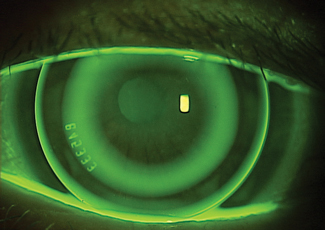 |
|
Compared to ortho-K lenses with a conventional treatment zone, this study found that small treatment zone lenses more effectively reduced axial elongation at both 12 and 18 months of follow-up. Additionally, since the measurement was affected by retinal visual quality, the authors suggest axial elongation may help explain how ortho-K prevents myopia progression. Photo: Robert Ensley, OD, and Heidi Miller, OD. Click image to enlarge. |
Given the increasing popularity of orthokeratology (ortho-K) lenses as a means of slowing myopia progression in children, several randomized trials are currently underway to evaluate the efficacy and visual outcomes of different lens designs. Ortho-K lenses with a small treatment zone (STZ) have been proposed to yield improved myopia control compared to conventional treatment zone (CTZ) lenses by influencing factors like retinal visual signal quality. In a recent study comparing the long-term effectiveness of both designs, STZ lenses significantly decreased the rate of axial elongation compared to the CTZ ortho-K design, though the former led to poorer objective vision.
The randomized, double-masked trial included 140 children with myopia, ranging from eight to 12 years old; of these, 131 completed the study. Participants were randomly assigned to wear either STZ (n=68) or CTZ (n=63) ortho-K lenses; the former design was achieved by changing the depth of the reverse zone and the sagitta height of the optical zone. Axial length, spherical aberration and corneal topographic parameters were measured at multiple time points throughout follow-up to assess the lenses’ long-term effects.
Researchers found that at 12 and 18 months of treatment, the STZ group had significantly reduced axial elongation compared to the CTZ group after treatment (12 months: 0.07mm vs. 0.14mm; 18 months: 0.17mm vs. 0.26mm). The topography in the STZ group showed a smaller treatment zone diameter (2.50mm vs. 2.77mm), a wider defocus ring width (2.45mm vs. 2.30mm) and larger values of total amount of defocus (119.38 D/mm2 vs. 91.40 D/mm2) and total spherical aberration (0.37μm vs. 0.25μm) compared with the CTZ group.
In both treatment groups, objective visual quality decreased, demonstrated by changes in optical quality parameters including the modulation transfer function (MTF) cutoff, Strehl ratio, objective scattering index and predicted visual acuity. Conversely, subjective visual quality, which was measured with a patient questionnaire, showed no signifcant difference between those wearing STZ vs. CTZ ortho-K lenses.
In multivariate analysis, axial length changes were associated with sex, change of MTF cutoff value, increment of total spherical aberration and treatment zone area.
In their study, published in Eye and Vision, the researchers concluded, “Smaller treatment zone on the corneal surface formed after STZ ortho-K wearing, which then produced a greater spherical abberation, resulting in the lower contrast intensity of retina visual signal. This, in turn, led to a better control of myopia progression.” Furthermore, they found that axial elongation was affected by retinal visual quality and speculate that “it may be a mechanism by which ortho-K prevents myopia progression.”
Gong G, Zhang BN, Guo T, et al. Efficacy of orthokeratology lens with the modified small treatment zone on myopia progression and visual quality: a randomized clinical trial. Eye and Vision. 2024;11:35. |


